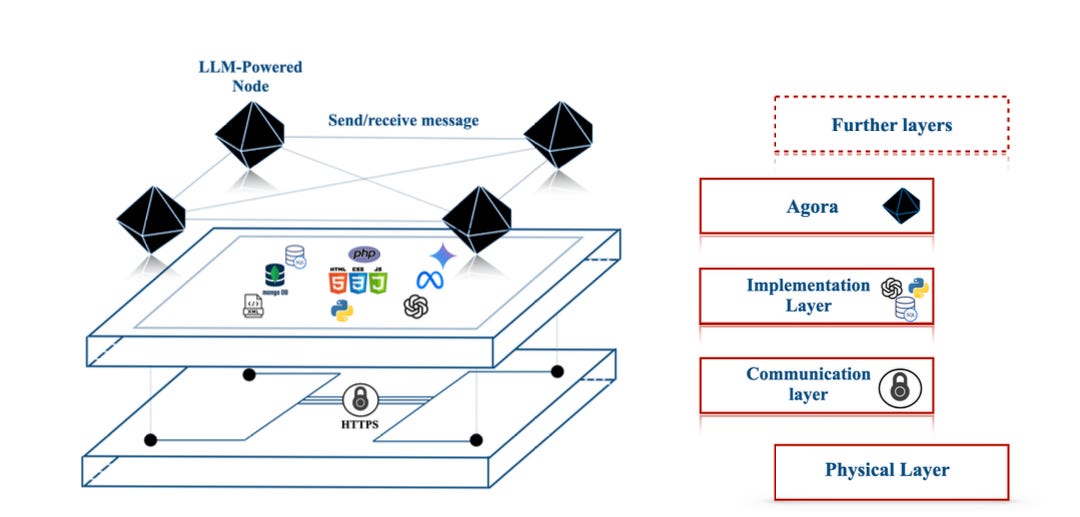Picture a world where artificial intelligence systems communicate as effortlessly as humans do. This is not science fiction - it is becoming reality through Agora, a revolutionary protocol that's transforming how AI systems interact. By solving what is known as the "Communication Trilemma" Agora is paving the way for truly collaborative artificial intelligence.
The Communication Challenge
Consider how humans communicate - we can discuss any topic, switch between formal and casual language, and adapt our communication style based on context. Now imagine trying to give these same capabilities to AI systems. That is the challenge Agora addresses.
Modern AI systems are incredibly diverse. Some analyze market data, others process weather information, and many handle customer service interactions. Each system needs to communicate about different topics, yet traditional communication methods struggle with this variety. When AI systems communicate using natural language processing, every interaction consumes substantial computational resources and time - imagine running a translation service for every conversation between computers.
Making matters more complex, different AI models have different architectures and capabilities. It is like having a room full of people speaking different languages, each with their own unique way of thinking. Creating a communication system that works seamlessly across this diverse ecosystem while remaining efficient has been a significant challenge - until now.
A New Approach to AI Communication
Agora introduces a brilliant solution through its meta-protocol structure. Rather than forcing all AI systems to communicate in the same way, it creates a flexible framework that adapts based on communication patterns and needs. Think of it as creating a universal translator that can switch between different languages and communication styles as needed.
At the heart of Agora lies the concept of Protocol Documents (PDs). These are like communication rulebooks that any AI system can read and understand, regardless of its underlying architecture. What makes this approach particularly powerful is its three-tier communication system.
For frequent, routine communications, Agora uses established, efficient protocols - similar to how humans might use standardized forms for common requests. When communications are less frequent, it employs a hybrid approach where structured data formats are combined with AI processing - comparable to how we might switch between formal and casual language depending on the situation. For rare or complex situations, Agora allows AI systems to communicate using natural language, serving as a fallback mechanism when other methods aren't suitable.
The Magic of Self-Organization
One of the most fascinating aspects of Agora is its ability to develop new protocols without human intervention. During testing with 100 AI agents, systems spontaneously developed efficient communication patterns for complex tasks.
Take, for example, a food delivery service network that emerged during testing. The AI systems independently developed protocols for handling everything from initial order processing to delivery coordination and traffic optimization. Each step evolved its own efficient protocol, creating a seamless system that operated without human oversight. It's similar to how human societies naturally develop conventions and protocols for common activities.
Real Results and Cost Savings
The practical benefits of Agora are substantial. In extensive testing with a network of 100 AI agents handling various tasks, communication costs dropped from $36.23 to $7.67 per 1,000 queries. This network included different types of AI models working together seamlessly, demonstrating Agora's versatility across different AI architectures.
As more protocols were established and shared between agents, the system's efficiency progressively improved. Think of it as AI systems learning to communicate more efficiently over time, much like how human communities develop more efficient ways of working together.
Looking Ahead
The possibilities Agora opens up are vast. In business, it enables automated process coordination and complex decision-making systems. For research, it facilitates distributed AI collaboration and automated scientific discovery. In public services, it can enhance everything from smart city management to emergency response coordination.
While some challenges remain - such as initial setup complexity and the need for careful monitoring - Agora represents a fundamental shift in how AI systems can work together. It is not just solving current communication challenges; it is laying the groundwork for future innovations in AI collaboration.
The Path Forward
As artificial intelligence becomes increasingly integral to our daily lives, the ability for AI systems to communicate efficiently and effectively becomes crucial. Agora is not just another technical protocol - it is a foundation for a future where AI systems can truly work together, solving complex problems and handling sophisticated tasks with unprecedented efficiency.
The journey toward truly collaborative artificial intelligence has taken a significant step forward with Agora. By enabling AI systems to communicate more effectively, we are opening the door to possibilities that were previously out of reach. The future of AI communication is here, and it's more promising than ever.
Conclusion
Agora represents a fundamental shift in how AI systems can work together. By solving the communication trilemma through its innovative meta-protocol approach, it opens new possibilities for AI collaboration and automation. The protocol's ability to facilitate emergent behaviors and self-organize efficient communication patterns points to a future where AI systems can work together more effectively than ever before.












Share this post